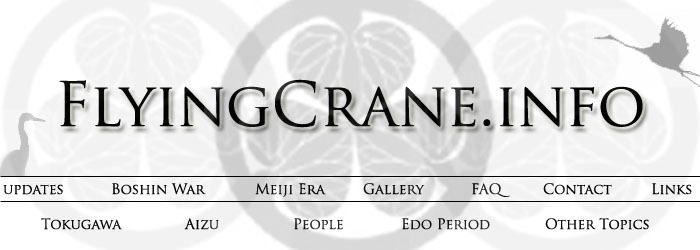

| ::HAYASHI TADATAKA :: This page is a work in progress. Check back soon!
::New Years' Rabbits :: To understand the special bond between the two families, it is necessary to go centuries back from Tadataka, to the Muromachi Era (1336-1573). The shugo (governor) of Shinano Province was one Ogasawara Kiyomune, and his second son, Mitsumasa, had his holdings around Hayashi Village. During the Eikyo Rebellion of 1438-39, Serata Arichika and Chikauji, while escaping the conflict, came to Hayashi Village. As it was the New Year's holiday, and he knew Arichika, Mitsumasa wanted to have something to present to them as a banquet, but he had nothing. Faced with the prospect of not being able to entertain his guests, Mitsumasa went out into the freezing cold and deep snow, and caught rabbits. Returning to his residence, he served them, smoked, to his two guests. Chikauji, who later moved to Mikawa and assumed the Matsudaira surname, said "That rabbit dish was truly auspicious," and, granting the family name "Hayashi" to Mitsumasa, invited him to come and serve as a samurai-taisho (army commander). After this, on every New Year's, the Matsudaira family would first accept smoked rabbit from Mitsumasa. The Hayashi family, from this point on, took this duty very seriously, and would hunt for rabbits at the end of every year, preparing them in smoked condition for the head of the Matsudaira family (later the Shogun) to enjoy at every New Year. A poem (haiku) later appeared which described this function:"Till Maitreya's age/they will present smoked rabbit/to the lord" Because of their special status as being the first presenters on the New Year, they were first to receive a cup of sake, and thus the kanji for "one" (ichi) was added to their crest. This practice was to continue throughout the Sengoku period, and into the Edo period, which saw the Hayashi as hatamoto for much of its history. ::Edo Era- From Taishin-Hatamoto to Fudai Daimyo :: The Hayashi remained as direct vassals of the Matsudaira/Tokugawa clan of Mikawa throughout the Sengoku and Azuchi-Momoyama periods, becoming hatamoto in the newly established Tokugawa shogunate. The family head in 1614-15, Hayashi Yoshitada, took part in the Osaka Campaign, and was killed in action. In gratitude for his sacrifice, the Tokugawa shogunate granted Yoshitada's son Tadakatsu with a stipend of 300 hyo of rice from the Shogunal storehouses. To this was added a private landholding of 500 koku. Tadakatsu's son Tadataka (spelled differently than the later Tadataka) was a direct Shogunal assistant, and saw his income increase to 2500 koku of land and 500 hyo from Shogunal granaries. Tadataka's son Tadakazu had his income reorganized and combined, bringing the family's private landholdings up to 3000 koku. With income at this level, the Hayashi were counted among the ranks of taishin-hatamoto, men who were below the 10,000 koku threshold that set daimyo apart, but whose income was above 1,000 koku.During the lifetime of Hayashi Tadafusa (1765-1845), this was to change. Tadafusa was called into direct shogunal service in 1781, at age 16, when he became the wardrobe supervisor and close assistant of the shogunal heir, Tokugawa Ienari. Succeeding to his family's headship in 1796, at age 31, he continued to serve in the shogunate for the rest of his career. In 1825, he was promoted from shogunal liaison officer (soba-goyo-toritsugi) to wakadoshiyori (junior councilor), and granted a stipend increase. This pushed his income level above the 10,000 koku line, and he went from being a taishin-hatamoto to being a fudai daimyo; in charge of his own domain but still technically vassal to the shogun. ::Kaibuchi-han:: The Hayashi family's new han (domain) was located in Kazusa Province (modern-day Chiba Prefecture), and was known as Kaibuchi-han. It took its name from Kaibuchi Village, where it was established: a small community on the coast of the strategic Boso Peninsula, overlooking Edo Bay. Nine years after its creation, the domain was increased by another 3,000 koku. In 1839 it was expanded by another 5,000 koku, at which point Kaibuchi was at its largest size: 18,000 koku in all. However, Tadafusa lost his position with the death of his patron Ienari, and after being forced into retirement, his income was reduced to 10,000 koku. Tadafusa passed on the family headship, and spent the next few years in retirement before dying in 1845.::Jozai-han:: Tadafusa's 2nd son Tadaakira (1841-1867) was the second Hayashi daimyo. During Tadaakira's tenure, the Kaibuchi domain's center was shifted to Jozai Village (modern-day Kisarazu City), where Mabune-jinya, the Hayashi family's residence and administrative headquarters, was built. The residence at Kaibuchi was made into a storehouse, and as of 24 January 1851, the domain was thus renamed Jozai-han.In 1853, with the arrival of Commodore Perry and the U.S. Navy's East India Squadron, Jozai-han came to a position of strategic importance, due to its position on the Boso Peninsula. On 9 July 1853, the day after Perry's arrival, coastal defenses were strengthened on the Kaibuchi waterfront. They remained this way through the tense months of negotiation that followed, with defenses only being eased on 19 April 1854, several weeks after the Treaty of Kanagawa was concluded (31 March). Adapted from: *Hayashi Tadataka Jisei no Ku (in Japanese) *Jozai-han Hayashi Genealogy (in Japanese) *Matsumoto Castle History/Ogasawara family background (in Japanese) *Hayashi Tadataka Biography (in Japanese) *Bolitho, Harold. Politics in the Tokugawa Bakufu, 1600-1843. Berkeley: University of California Press, 1988. *Bolitho, Harold. The Collapse of the Tokugawa Bakufu. Honolulu: University of Hawai'i Press, 1980. *---. "Jozai-han," in Hanshi-Daijiten Vol. 2, edited by Kimura Motoi et. al., 526-528. Tokyo: Yuzankaku, 2002.
|